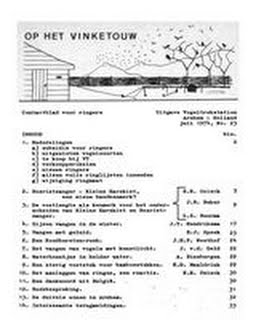1974
De voetlengte als kenmerk voor het onderscheiden van Kleine Karekiet (Acrocephalus scirpaceus) en Bosrietzanger (Acrocephalus palustris)
Publication
Publication
Op het Vinkentouw , Volume 23 - Issue 1 p. 9- 16
According to Leisler (1972), the Marsh Warbler( Acrocephalus palustris) has a smaller foot, with shorter toes than Reed Warbler (Acrocephalus scirpaceus) birds with an inner foot span less than 26.0 are Marsh Warblers. During July, August and September 1973 more than 1350 Reed- and Marsh Warblers were trapped by the authors in the Netherlands. In order to check the reliability of the criterion presented by Leisler a number of measurements have been taken. On the ground of the winglength (Fig. 1) the authors found that only a small proportion of the trapped birds could consist of Marsh Warblers, probably less than 5% (cf. Tabel 1) The inner footspan of the trapped birds is presented in Tabel 3 and Figuur 2. When using Leisler’s criterion, 24.5% of the material (adult birds) consisted of Marsh Warblers. This result is at variance with the findings based on the winglengths of these birds. Moreover, these ”Marsh Warblers” have uncharacteristic winglengths for the species (Tabel 2 en Figuur 3). From this we conclude that the inner foot span is not reliable for separating Reed and Marsh Warbler. Finally, there is an indication that Reed Warblers trapped in the Netherlands have smaller feet than those trapped in Austria.
| Additional Metadata | |
|---|---|
| Op het Vinkentouw | |
| CC BY 3.0 NL ("Naamsvermelding") | |
| Organisation | Vogeltrekstation |
|
onbekend. (1974). De voetlengte als kenmerk voor het onderscheiden van Kleine Karekiet (Acrocephalus scirpaceus) en Bosrietzanger (Acrocephalus palustris). Op het Vinkentouw, 23(1), 9–16. |
|
